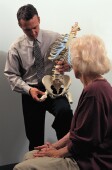- Navigating Your Midlife Crisis: Embracing New Possibilities
- City Raccoons Showing Signs of Domestication
- Mapping the Exposome: Science Broadens Focus to Environmental Disease Triggers
- One Week Less on Social Media Linked to Better Mental Health
- Your Brain Changes in Stages as You Age, Study Finds
- Some Suicide Victims Show No Typical Warning Signs, Study Finds
- ByHeart Formula Faces Lawsuits After Babies Sickened With Botulism
- Switch to Vegan Diet Could Cut Your Greenhouse Gas Emissions in Half
- Regular Bedtime Does Wonders for Blood Pressure
- Dining Alone Could Mean Worse Nutrition for Seniors
Early Scans for Back Pain May Do Little to Help Seniors


Most current guidelines suggest that when seniors report new back pain to their primary care physician they should quickly be sent for diagnostic imaging, such as CT scans or MRIs.
But a new study suggests that early imaging may actually be a waste of both time and money.
“Older adults with back pain who seek care and get imaging within six weeks of their doctors visit for back pain do not have better outcomes than similar older adults who do not get early imaging,” said study author Dr. Jeffrey Jarvik. He is a professor of radiology, neurological surgery and health services at the University of Washington, in Seattle.
In fact, Jarvik noted that “although early imaging is not associated with better pain and function outcomes, it is associated with greater use of health care services, such as visits [and] injections.” And that, he said, “translates into a nearly $1,500 per patient additional cost, for no measurable benefit.”
“This is the opposite of ‘high-value health care,’ ” said Jarvik, who’s also an adjunct professor in health services, pharmacy, and orthopedics and sports medicine at the university. “No benefit at great cost.”
Jarvik reports his team’s findings in the March 17 issue of the Journal of the American Medical Association.
The researchers noted that the American College of Radiology guidelines state that early MRIs are “appropriate” for patients aged 70 and up, as well as for osteoporosis patients aged 50 and older.
To assess the impact of early back scanning on back pain management among seniors, the study authors focused on more than 5,200 patients over the age of 65 who sought care between 2011 and 2013 for a fresh bout of lower back pain.
Of those, more than 1,500 were sent for some form of back imaging within six weeks of their initial doctor’s visit.
The team then reviewed electronic medical records to tally what kind of services patients used in the year following their first doctor’s visit. They also analyzed responses the seniors gave in a back and leg pain disability questionnaire.
The result: None of the patients who had early scanning fared significantly better than those who did not get an early scan.
At the same time, those who did have early scanning ended up spending roughly $1,400 more on back pain care during the study.
Jarvik stressed that he believes that those doctors who ordered early imaging were simply following guidelines, in an effort to offer the best care possible. He noted, for example, that all were members of HMOs, a health-care setting in which doctors would generally be encouraged to limit costs and avoiding excess testing whenever possible.
“I’m fairly confident that financial gain did not play an important role in prompting primary care providers to order imaging tests in our study,” he noted.
That said, “now we have strong evidence that, as a routine, early imaging should not be done,” Jarvik added.
Dr. John Mafi, a fellow in the department of general internal medicine at both Beth Israel Deaconess Medical Center and Harvard Medical School in Boston, described the study as “a very well-done analysis.”
“There is a lot of overuse going on in health care,” he noted. “And there is a general bias to do more, among both doctors and patients. But what’s being tackled here is not actually about overuse. Here, the physicians were not wrong. They were just following guidelines regarding seniors, which are grounded in the idea that as you age the likelihood that some serious problem is causing your back pain is higher than if you’re younger.”
“But as it turned out,” said Mafi, “the actual evidence for these guidelines ended up being pretty weak.”
More information
Visit the U.S. National Institute of Arthritis and Musculoskeletal and Skin Diseases for more on back pain.
Source: HealthDay
Copyright © 2025 HealthDay. All rights reserved.










